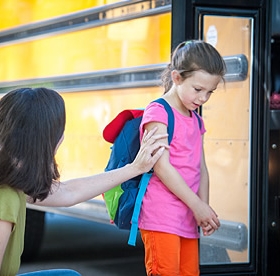Article at a Glance
- Anxiety is a normal part of life but becomes a problem if it persists or starts to interfere with day-to-day life.
- Some types of anxiety are a normal part of child development.
- Help your child learn how to cope with anxiety by allowing them to talk and teaching them relaxation techniques.
Anxiety isn’t just a grown-up emotion, kids also feel anxious. Feeling some anxiety is a normal part of life and helps children deal with more challenging experiences later on.
Anxiety is when we feel dread, fear, or worry when there isn’t any immediate or real danger. When we feel anxious we often experience an elevated heart rate or our stomach feels like it is tied up in knots.
Developmental Stages
During childhood, some types of anxiety are a normal part of growing up. They often come and go depending on the developmental stage. Some can even be helpful. For example, separation anxiety can keep your toddler from wandering off.
- Separation Anxiety: When a child is anxious about being separated from a parent. Usually occurs between 10 to 18 months old, but is also common when children are starting school.
- Stranger Anxiety: When children are scared of people they don’t know. This is especially common with babies.
- Fantastical Fears: Between the ages of 4 and 6 children may be afraid of fantastical things like monsters or ghosts. Often children are scared of the dark because they are afraid of what it might be concealing.
- Realistic Fears: Around 7 to 12 years old fears become more grounded in reality. Children might become afraid of earthquakes, bugs, international events, car accidents, or losing a family member. Children and teens might worry about peer acceptance or grades.
Signs of Anxiety
Children experience anxiety for different reasons. For some, it might depend on the particular situation. For example, a child might be scared to go under the water in a swimming pool but not in the bathtub. Fears and anxieties might also stem from previous unpleasant experiences or a fear of change.
Some signs of anxiety include:
- Problems sleeping or nightmares
- Nausea or upset stomach
- Headaches
- Nervous twitches
- Sweaty hands
- Rapid breathing or heartbeat
- Unusual behavior like impulsivity, distractedness, clinginess, or meltdowns
Helping Your Child
Usually if the fear or anxiety is age appropriate it will probably resolve itself. The best thing you can do is to provide comfort and teach some coping skills.
Here are some things you can do to help:
- Allow your children to talk about their fears. Things like role playing, drawing comparisons, or talking about potential outcomes can help children process and resolve their own feelings. But don’t allow them to dwell on things. Show your child how to focus on the positive. For example, teach your child to repeat positive phrases like “I will be okay” when feeling anxious.
- Children can learn how to evaluate their fears and put them into context by learning how to rate them. For example, your child might decide that her fear of dogs is only a 6, which isn’t nearly as bad as a 10. As she works through her fear she can assess her progress—helping her to feel in charge and successful.
- Don’t minimize your child’s fears even though they may seem insignificant to you.
- You can’t force children to overcome their fears. Begging, threatening, or bribing doesn’t work. However, sheltering children from their fears does not work either. Avoidance only reinforces the idea that there is something to be scared of. Instead provide exposure in small doses. Be supportive, stay calm, and help them manage their fear.
- Monitor your child’s media exposure. If your child worries about things, you may not want to watch the news while your child is in the same room. Or you may need to wait a few years before your child can watch scary movies.
- Be a good example. We can often pass down our own worries and fears. You don’t have to hide all our fears; instead, share some that are age appropriate and talk about how you have overcome them.
- Nothing is scarier than the unknown. Taking through an upcoming experience can help children know what to expect and calm some of their anxieties.
- Books can be a great way for children to see how others have dealt with their fears.
- Studies have shown that things like holding hands, getting a back rub, or hugging can lower our heart rate and make us feel less anxious. Cuddling with your pet can also help.
- Teach your child relaxation techniques like deep breathing, imagining yourself some place relaxing, or listening to soothing music.
When to Get Help
Over time fears may develop into a phobia—a persistent fear of something that leads to extreme measures to avoid it. Talk to your doctor if your child’s fears or anxieties don’t go away, start to interfere with your child’s day-to-day life, become extreme, or cause long-lasting physical symptoms.
More Information:
Anxiety and Depression Association of America: Children and Teens (adaa.org)
Anxiety, Fears, and Phobias (kidshealth.org)
Share this article:
